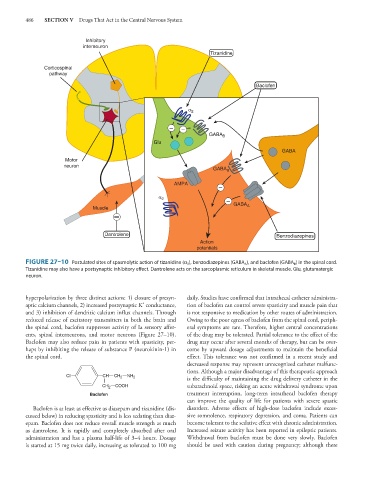Page 500 - Basic _ Clinical Pharmacology ( PDFDrive )
P. 500
486 SECTION V Drugs That Act in the Central Nervous System
Inhibitory
interneuron
Tizanidine
Corticospinal
pathway
Baclofen
α 2
– –
GABA B
Glu
GABA
Motor
neuron
GABA B
AMPA
–
α 2
–
Muscle GABA A
–
Dantrolene Benzodiazepines
Action
potentials
FIGURE 27–10 Postulated sites of spasmolytic action of tizanidine (α 2 ), benzodiazepines (GABA A ), and baclofen (GABA B ) in the spinal cord.
Tizanidine may also have a postsynaptic inhibitory effect. Dantrolene acts on the sarcoplasmic reticulum in skeletal muscle. Glu, glutamatergic
neuron.
hyperpolarization by three distinct actions: 1) closure of presyn- daily. Studies have confirmed that intrathecal catheter administra-
+
aptic calcium channels, 2) increased postsynaptic K conductance, tion of baclofen can control severe spasticity and muscle pain that
and 3) inhibition of dendritic calcium influx channels. Through is not responsive to medication by other routes of administration.
reduced release of excitatory transmitters in both the brain and Owing to the poor egress of baclofen from the spinal cord, periph-
the spinal cord, baclofen suppresses activity of Ia sensory affer- eral symptoms are rare. Therefore, higher central concentrations
ents, spinal interneurons, and motor neurons (Figure 27–10). of the drug may be tolerated. Partial tolerance to the effect of the
Baclofen may also reduce pain in patients with spasticity, per- drug may occur after several months of therapy, but can be over-
haps by inhibiting the release of substance P (neurokinin-1) in come by upward dosage adjustments to maintain the beneficial
the spinal cord. effect. This tolerance was not confirmed in a recent study and
decreased response may represent unrecognized catheter malfunc-
tions. Although a major disadvantage of this therapeutic approach
CI CH CH 2 NH 2 is the difficulty of maintaining the drug delivery catheter in the
CH 2 COOH subarachnoid space, risking an acute withdrawal syndrome upon
Baclofen treatment interruption, long-term intrathecal baclofen therapy
can improve the quality of life for patients with severe spastic
Baclofen is at least as effective as diazepam and tizanidine (dis- disorders. Adverse effects of high-dose baclofen include exces-
cussed below) in reducing spasticity and is less sedating than diaz- sive somnolence, respiratory depression, and coma. Patients can
epam. Baclofen does not reduce overall muscle strength as much become tolerant to the sedative effect with chronic administration.
as dantrolene. It is rapidly and completely absorbed after oral Increased seizure activity has been reported in epileptic patients.
administration and has a plasma half-life of 3–4 hours. Dosage Withdrawal from baclofen must be done very slowly. Baclofen
is started at 15 mg twice daily, increasing as tolerated to 100 mg should be used with caution during pregnancy; although there

